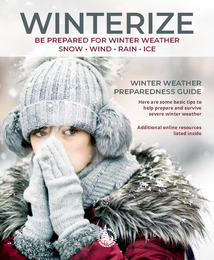
Snow, ice and extreme cold can play havoc with a city's transportation system and have an impact on residents' homes. However, a bit of planning before the extreme weather and following common-sense tips once a storm has hit can limit problems.
To learn more about preparation and response to snow and ice in Bellevue, check out the answers to frequently asked questions. The National Weather Service has current forecasts and safety information on their website. The Take Winter By Storm website also offers helpful information for preparing for snow and ice.
Winterize Guide
The "Winterize" weather preparedness guide, also available in other languages, offers downloadable tips and resources.
Winter Cautions
We offer essential cautions for winter in English, Chinese, Spanish, Vietnamese, Russian and Japanese.
- English
- 繁體中文 (Chinese)
- Español (Spanish)
- 한국어 (Korean)
- 日本語 (Japanese)
- Русский (Russian)
- Tiếng Việt (Vietnamese)
City's Snow Response
The Transportation Department begins preparing early for the snow season by getting snow equipment ready, stockpiling supplies, and training staff for emergency response. The city's snow response priorities map shows which city streets will be plowed first. The city's Transportation, Police and Fire departments work together to create the map. The focus is on community health and safety and on doing the most good for the most people.
During a snow storm, major streets and neighborhood priority routes are cleared first to accommodate fire, medical and police response, as well as transit, school buses and commuter traffic. If snowfall is continuous, those arterials may require repeated plowing and sanding before crews can clear neighborhood streets.
To report hazardous road conditions, call the Operations and Maintenance 24-hour Emergency Response line 425-452-7840. To report power outages or downed power lines, call Puget Sound Energy at 1-888-225-5773.
Driving on Ice and Snow
Ice and snow, combined with Bellevue's steep hills, can make for hazardous driving conditions. Winter driving tips include slower speeds, slower acceleration, slower steering, slower braking, and:
- Check conditions: When you see snow or ice forecast, plan ahead. Talk to your employer, local school or day-care center. The Washington Department of Transportation (WSDOT) offers reports on highway conditions with online Statewide Traveler Information. If conditions appear hazardous, don't leave home unless it's absolutely necessary.
- Extra time: Give yourself extra time. It's not worth putting yourself and others in a dangerous situation just to be on time.
- Chaining up: A short how-to video by WSDOT, posted on YouTube, shows the basic steps for putting chains on your car.
- Before leaving home: Pack winter safety equipment and a breakdown kit in your vehicle. Prepare your vehicle by packing a shovel, flashlight, blankets and chains or cables for the tires along with a breakdown kit.
- Driving tips: The faster you're going, the longer it will take to stop. When braking, do so slowly and never slam the brakes. If you have anti-lock brakes, press on the pedal down firmly and hold it. If you don't have anti-lock brakes, gently pump the pedal.
- Black ice: Roads that seem dry or just wet may actually be slippery with black ice. Take it slow when approaching intersections, off-ramps, bridges or shady areas, common places for black ice.
- Snowplows: Give snowplows room to work. The plows are wide and can cross the centerline or shoulder. Do not tailgate and try not to pass. If you must pass, use extreme caution and beware of the snow cloud.
Home Safety
Severe cold can freeze the water in your pipes, causing them to burst. Be cautious with alternative ways of heating your home. If freezing temperatures are in the forecast, take the following steps:
- Drip warm water from the indoor faucet farthest from where water enters the house.
- Insulate outdoor faucets and pipes in unheated garages and crawl spaces with newspaper, rags or other insulating material. Cover with plastic and secure with string or wire. It's okay to insulate the outside of your meter box, but please don’t put materials such as Styrofoam peanuts inside, as this makes it difficult for city workers to access.
- If a water pipe breaks, immediately turn off the main water shut-off valve and/or water meter to control flooding and water damage. Call a plumber. The main water shut-off valve is usually located in the basement, garage or outside near the foundation. If there is no main shut-off valve, there is a valve in the meter box that can be used in an emergency. Turn clockwise with an adjustable wrench.
- If you use a kerosene heater, make sure there is plenty of ventilation. Keep heaters away from curtains and clothing, and make sure heaters are turned off before going to bed. Never use a gas or charcoal barbeque indoors. Do not leave children or pets alone with a portable heater.
Illustrated Guides
Want to know some tips for what to do when it snows? The pictograms on this page, presented in multiple languages, are helpful.
What should you do when it's icy outside? The pictograms on this page, presented in multiple languages, are helpful.
